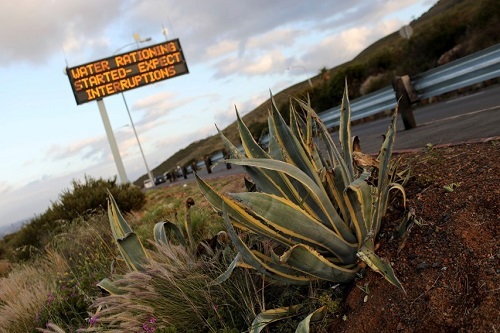Reuters photo
By
Jose Kalathil
The Centre for Science and Environment (CSE), a New Delhi-based not-for-profit organisation, has warned that many of the world’s leading cities will see Cape Town-like water crisis in the not too distant future, unless cities innovate, diversify supply sources and use water judiciously.
Down To Earth, its monthly magazine, in its latest issue, released on this year’s World Water Day, on March 22, said at least 200 cities worldwide are fast running out of water and 10 metropolitan cities are moving quickly towards Day Zero. These cities include Bengaluru, in India, Beijing in China, Mexico City in Mexico, Sanaa in Yemen, Nairobi in Kenya, Istanbul in Turkey, Sao Paulo in Brazil, Karachi in Pakistan, Buenos Aires in Argentina, and Kabul in Afghanistan.
The magazine predicted that at present about 400 million people live in cities with perennial water shortage, and the number might go up to 1 billion by 2050. It also said that 36 per cent of cities across the world will face a water crisis by 2050. It added that urban water demand is expected to go up by a whopping 80 per cent by 2050.
In 2015, Cape Town, one of Africa’s richest cities, bagged the C40 Cities Awards for its Water Conservation and Water Demand Programme. By 2017-18, the city was in the throes of an unprecedented water shortage. It is estimated that the city’s taps will run dry this year, within the next few months. But, the city, that relies on rainwater to fill up its six reservoirs, had a below average rainfall from 2015-17, which contributed to the drying up of these reservoirs. In fact, the Western Cape region where Cape Town is situated has been undergoing a massive drying up process – a process linked to climate change — since 2015.
In the case of Bengaluru, the reason mentioned is that the number of waterbodies has reduced by 79 per cent due to unplanned urbanization and encroachment, while built-up areas have increased from 8 per cent in 1973 to 77 per cent now; the water table has shrunk from 10-12 metres (m) to 76-91 m in just two decades; the number of extraction wells has gone up from 5,000 to 0.45 million in just 30 years; the city only uses half of its treatment capacity to treat waste and a substantial amount is dumped into its waterbodies. Moreover, the city’s population might reach 20.3 million by 2031 – and is growing by 3.5 per cent annually.
In the case of Beijing, more than 200 rivers and streams have all dried up. For the past three decades, the city has survived by digging, boring and drilling groundwater. Hydrologists warn that groundwater is depleting at a rate of 1 metre per year and becoming polluted.
In Mexico City, 700 years ago, the Aztecs built a city of floating gardens, known as the “Venice of the New World”. Over the years, the lakes that once filled the plains have been steadily drained by settlers. The lake beds now remain covered by a grey sea of concrete, tarmac and steel, forcing the city to source its supplies by pumping water from hundreds of metres underground or from a distance of over 100 kilometres. Moreover, the devastating floods of 2013 have contaminated the groundwater and extraction wells in the city. And while over-extraction of groundwater has caused the city’s soft base to sink at 40 cm per year, transporting billions of litres to the megalopolis at 2,400 metres above the sea level through seismically active mountains is fraught with danger.
In Sanaa, after exploiting the last drops of groundwater, the city is now looking for alternative sources. According to the World Bank, the groundwater level in the basin has fallen from 30 metres in the 1970s to around 150 metres in the 1990s. Media reports speculate that the city may reach Day Zero by 2019.
In Nairobi, the city is so heavily dependent on groundwater that it plunges into a crisis every time the monsoon plays truant. Approximately 75% of Nairobians buy water from the kiosks and pushcart vendors at a higher price – up to 300 times the supply rate – because they are either not covered under the city’s water supply system or do not receive adequate supply. Even though the city started rationing water in 2016, the crisis is likely to continue until 2026.
In Istanbul, the decline in the water table is due to unsustainable extraction ranges from 30-150 metres in some areas. By 2020 the demand-supply gap will reach 607 million cubic metres per year, says a 2015 study.
In 2015, Sao Paulo experienced its greatest water crisis in over 80 years. Residents endured 12-hour water cut-offs daily; the licences that authorize businesses, agricultural enterprises and private entities to draw directly from rivers, reservoirs and artesian wells being suspended. Scientists blame the large-scale felling of rainforests in the Amazon basin as a major cause of drought. Moreover, the city loses 30 per cent of its treated supply due to leaks in the piping system.
In Karachi, the Karachi Water and Sewerage Board (KWSB) barely meets 50 per cent of the city’s total water requirement, while the city’s population is growing at a rate of 5 per cent per annum. The worsening water crisis has even been the cause of civil unrest in 2016. However, dearth of water is not the only reason the city is water-stressed, people here also suffer due to lack of sufficient clean and potable water, while outbreaks of water-borne diseases are now a regular feature of the city.
In Buenos Aires, dotted with water-bodies and crisscrossed by the La Plata river, the city has no reason to be water-stressed. But unchecked expansion of industrial units, including tanneries, along the shores of the river has polluted it with heavy metal-laced industrial waste. Since 1940, the city has turned to groundwater to meet its growing industrial and private consumption demands. However, according to a WWF report, groundwater at several places in the city is no longer potable.
In Kabul, bombings have destroyed a large section of supply networks and treatment facilities in this city, where only 20 per cent of residents have access to treated water. While, in Kabul, conflict is the main reason people do not have access to potable water, in many other cities water is leading to more conflicts.
Speaking on the severe water crisis the world is facing, Sunita Narain, director general, CSE, said, “Be it Cape Town, Bengaluru or Chennai, there isn’t much difference between these cities – they are all witnessing a common present. The important question to ask is whether these cities can create and move toward a common future that is water secure because it is water-wise.”
Jose Kalathil
Jose Kalathil is a senior journalist based in New Delhi. With more than three decades of experience in different publications in India and Nepal, he is comfortable writing on any topic under the sun.



No Comments Yet!
You can be first to comment this post!